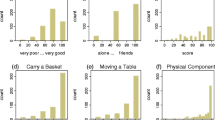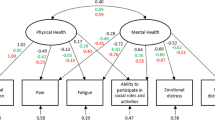Abstract
The Photo Elicitation Semantic Differential scale (PESD), developed to examine the social perception of disability and attitudes towards people with a disability (PwD), comprises six dimensions: communicativeness, competence, attractiveness, intelligence, industriousness, and popularity. This paper aims to assess the construct validity, test-retest reliability, and internal consistency of the PESD. A longitudinal study with 40 participants of the Swiss general population and 2 (test-retest) * 8 (different photographs) measurements per subject was performed. Construct validity was examined via Principal Component Analysis (PCA), test-retest reliability via the Intraclass Correlation Coefficient (ICC) and a frequency analysis of deviations among test-retest scores, and internal consistency via Cronbach’s alpha. PCA extracted two factors corresponding to hard and soft skills for the test and a single factor for the retest. ICCs ranged from 0.44 (industriousness) to 0.60 (intelligence). Deviations between tests exceeding +/-1 were rather rare ranging from 6% (intelligence) to 14% (competence). Cronbach’s alpha equalled 0.814 and 0.858 for test and retest, respectively. Summarising, in our study the PESD appears to be a valid and reliable tool for the examination of the social perception of disability and attitudes towards PwD.

Similar content being viewed by others
References
Bonfranchi, R., Mayer, E., & Rupp, D. (2002). Visueller Eindruck—geistige Behinderung—gesellschaftliche Bedeutung. Oberhausen: ATHENA-Verlag.
Brown, W. (1910). Some experimental results in the correlation of mental abilities. British Journal of Psychology, 3, 296–322.
Clark-Ibáñez, M. (2004). Framing the social world with photo-elicitation interviews. The American Behavioral Scientist, 47(12), 1507–1527.
Cronbach, L. J. (1951). Coefficient alpha and the internal structure of tests. Psychometrika, 16, 297–334.
Devine, P. G. (1989). Stereotypes and prejudice: their automatic and controlled components. Journal of Personality and Social Psychology, 56, 6–18.
Gething, L., & Wheeler, B. (1992). The interaction with disabled persons scale: a new Australian instrument to measure attitudes towards people with disabilities. Australian Journal of Psychology, 44(2), 75–82.
Goffman, E. (1963). Stigma. Notes on the management of spoiled identity (First Touchstone Edition ed.). New York: Simon & Schuster.
Kaiser, H. F. (1960). The application of electronic computers to factor analysis. Educational and Psychological Measurement, 20, 141–151.
Leonard, R., & Crawford, J. (1989). Two approaches of seeing people with disabilities. Australian Journal of Social Issues, 24(2), 112–125.
Mercer, J., Andrews, H., & Mercer, A. (1983). The effects of physical attractiveness and disability on client ratings by helping professionals. Journal of Applied Rehabilitation Counseling, 14, 41–45.
Osgood, C. E. (1953). Method and theory in experimental psychology. Oxford University Press.
Reinhardt, J. D., Ballert, C. S., Fellinghauer, B., Lötscher, A., Gradinger, F., Hilfiker, R., et al. (2010). Visual impressions of disability and the social construction of the person. A randomized controlled field experiment using photo elicitation. Disability and Rehabilitation, Early online, 1-12.
Shrout, P. E., & Fleiss, J. L. (1979). Intraclass correlations: uses in assessing rater reliability. Psychological Bulletin, 2, 420–428.
Acknowledgements
The authors like to thank all participants of this study. In particular, we would like to thank all photo models. Furthermore, we thank all reviewers and the editorial office for their valuable feedback.
Declaration of interest
The authors report no conflicts of interest. The authors alone are responsible for the content and writing of the paper.
Author information
Authors and Affiliations
Corresponding author
Rights and permissions
About this article
Cite this article
Fellinghauer, B.A.G., Roth, A., Bugari, K. et al. Construct Validity, Test-Retest Reliability, and Internal Consistency of the Photo Elicitation Semantic Differential Scale (PESD) in Disability Studies. J Dev Phys Disabil 23, 257–265 (2011). https://doi.org/10.1007/s10882-010-9224-y
Published:
Issue Date:
DOI: https://doi.org/10.1007/s10882-010-9224-y




